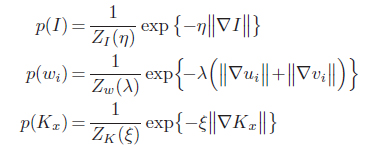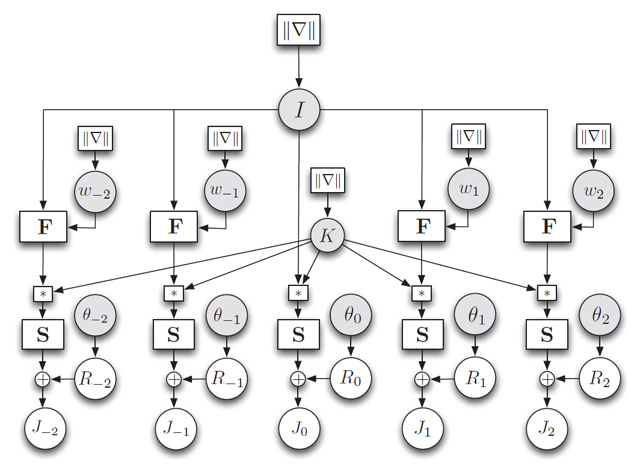IEEE
Conference on Computer Vision and Pattern Recognition (CVPR) 2011
A Bayesian
Approach to Adaptive Video Super Resolution
1Microsoft
Research New England 2Brown University
Abstract
|
|
|
Although
multi-frame super resolution has been extensively studied in past decades,
super resolving real-world video sequences still remains challenging. In
existing systems, either the motion models are oversimplified, or important
factors such as blur kernel and noise level are assumed to be known. Such
models cannot deal with the scene and imaging conditions that vary from one
sequence to another. In this paper, we propose a Bayesian approach to
adaptive video super resolution via simultaneously estimating underlying
motion, blur kernel and noise level while reconstructing the original
high-res frames. As a result, our system not only produces very promising
super resolution results that outperform the state of the art, but also
adapts to a variety of noise levels and blur kernels. Theoretical analysis of
the relationship between blur kernel, noise level and frequencywise
reconstruction rate is also provided, consistent with our experimental
results. |
Introduction
|
Figure 1. Demo
of our video super-resolution system.. For an input low-res
video, our system is able to reconstruct its high-res by 4x up-sampling rate. |
|
Multi-frame
super resolution, namely estimating the high-res frames from a low-res
sequence, is one of the fundamental problems in computer vision and has been
extensively studied for decades. The problem becomes particularly interesting
as high-definition devices such as HDTV's dominate the market. There is a great
need for converting low-res, low-quality videos into high-res, noise-free
videos that can be pleasantly viewed on HDTV's.
Although a
lot of progress has been made in the past 30 years, super resolving real-world
video sequences still remains an open problem. Most of the previous work
assumes that the underlying motion has a simple parametric form, and/or that
the blur kernel and noise levels are known. But in reality, the motion of
objects and cameras can be arbitrary, the video may be contaminated with noise
of unknown level, and motion blur and point spread functions can lead to an
unknown blur kernel.
Therefore,
a practical super resolution system should simultaneously estimate optical flow
[Horn 1981], noise level [Liu 2008] and blur kernel [Kundur
1996] in addition to reconstructing the high-res frames. As each of these
problems has been well studied in computer vision, it is natural to combine all
these components in a single framework without making oversimplified
assumptions.
In this
paper, we propose a Bayesian framework for adaptive video super resolution that
incorporates high-res image reconstruction, optical flow, noise level and blur
kernel estimation. Using a sparsity
prior for the high-res image, flow fields and blur kernel, we show that super
resolution computation is reduced to each component problem when other factors
are known, and the MAP inference iterates between optical flow, noise
estimation, blur estimation and image reconstruction. As shown in Figure 1 and
later examples, our system produces promising results on challenging real-world
sequences despite various noise levels and blur kernels, accurately
reconstructing both major structures and fine texture details. In-depth
experiments demonstrate that our system outperforms the state-of-the-art super
resolution systems [VH 2010, Shan 2008, Takeda 2009] on challenging real-world
sequences.
A Bayesian Model
The imaging
pipeline is shown in Figure 2, where the original high-res video sequence is
generated by warping the high-res source frame (enclosed by a red
rectangle) both forward and backward with some motion fields. The
high-res sequence is then smoothed with a blur kernel, down-sampled and
contaminated with noise to generate the observed sequence. Our adaptive video
super resolution system not only estimates the high-res sequence, but also the
underlying motion (on the lattice of original sequence), blur kernel and noise
level.
|
|
|
Figure 2. Video super resolution diagram.
The original high-res video sequence is generated by warping the source frame
(enclosed by a red rectangle) both forward and backward with some motion
fields. The high-res sequence is then smoothed with a blur kernel, downsampled and contaminated with noise to generate the
observed sequence. Our adaptive video super resolution system not only estimates
the high-res sequence, but also the underlying motion (on the lattice of
original sequence), blur kernel and noise level. |
Figure
2 can be translated to the graphical model in Figure 3.
|
|
|
Figure 3. The graphical model of video super
resolution. The circular nodes are variables (vectors), whereas the
rectangular nodes are matrices (matrix multiplication). We do not put priors η,
λ, ξ, α and β on I, wi, K, and θi for succinctness. |
We
use Bayesian maximum a posteriori (MAP) criterion to infer the optimum set of
unknown variables
![]()
Where the
posterior can be rewritten as the product of likelihood and prior
![]()
To deal
with outliers, we assume an exponential
distribution for the likelihood:
![]()
We use sparisty on derivatives to model the prior of the high-res image,
flow field and blur kernel

Naturally,
the conjugae prior for the noise parameter θi is a Gamma distribution
![]()
Our
optimization strategy is to fix three sets of parameters and estimate the
other. It is straightforward to find that we indeed itereate
the following four steps:
· Image reconstruction: infer I
· Motion estimation:
infer {wi}
· Noise estimation:
infer {θi}
· Kernel estimation:
infer K
It is clear
that these four classical computer vision problems need to be solved
simultaneously for video super resolution! The objective function has the form
of L1 norm. We use iteratively reweighted least square (IRLS) to solve this
convex optimization problem. The convergence procedure is shown in the
following video, where the Itertion # shows the outer
iteration where the four sets of variables are swept. IRLS # is the index of
inner iteration where the high-res image gets optimized. Clearly, the images gets sharper as the algorithm progresses. In
addition, the fact that the images gets dramatically sharper after the first
outer iteration indicates that better estimates of motion, noise level and blur
kernel lead to better estimate of the high-res image
|
Figure 4.
Convergence of our system. You may want to play the video multiple
times to see the optimization procedure. |
|
Study on noise
and blur
We collected 731 videos
consisting of 102,206 frames as our database for the experiments. The videos
are mostly of street scenes. One frame from each of the 731 videos was selected
as the query image and histogram intersection matching was used to find its 20
nearest neighbors, excluding all other frames from the query video. The SIFT
flow algorithm was then used to estimate the dense correspondence (represented
as a pixel displacement field) between the query image and each of its
neighbors. The best matches are the ones with the minimum energy.
|
Figure 4. Our
video super resolution system is robust to noise (click the figure to
enlarge). We added synthetic additive white Gaussian noise (AWGN) to the
input low-res sequence, with the noise level varying from 0.00 to 0.05 (top
row, left to right). The super resolution results are shown in the bottom
row. The first number in the parenthesis is PSNR score and the second is SSIM
score. |
|
|
|
Figure 5. PSNR
as a function of noise level. PSNR monotonically decreases as noise level
increases. |
Transition
|
Figure 6. Our
video super resolution system is able to estimate the PSF (click the figure
to enlarge). As we varied the standard deviation of the blur kernel (or
PSF) σk = 1.2, 1.6, 2.0, 2.4,
our system is able to estimate the underlying PSF. Aliasing causes
performance degradation for the small blur kernel σk
=1.2 (see text for detail). Top: bicubic
up-sampling (×4); middle: output of our system; bottom: the ground truth
kernel (left) and estimated kernel (right). The first number in the
parenthesis is PSNR score and the second is SSIM score. |
|
|
|
Figure 7. PSNR
as a function of blur kernel. There is a peak of PSNR as we increase the
size of blur kernel. |
To evaluate the matching
obtained by SIFT flow, we performed a user study where we showed 11 users image
pairs with 10 preselected sparse points in the first image and asked the users
to select the corresponding points in the second image. This process is
explained in Figure 12. The corresponding points selected by different users
can vary, as shown on the right of Figure 13 .
Therefore, we use the following metric to evaluate SIFT flow: for a pixel p, we
have several human annotations zi as its flow vector,
and w(p) as the estimated SIFT flow vector. We compute
the probability of one human annotated flow is within distance r to SIFT flow w(p). This function of r is plotted on the left of Fig. 13
(red curve). For comparison, we plot the same probability function (blue curve)
for minimum L1-norm SIFT matching, i.e. SIFT flow
matching without spatial terms. Clearly, SIFT flow matches better to human
annotation than minimum L1-norm SIFT matching.
|
|
|
Figure 8. PSNR
as a function of blur kernel. There is a peak of PSNR as we increase the
size of blur kernel. |
Experimental
Results
The goal is, given a
single static image, to predict what motions are plausible in the image. This
is similar to the recognition problem, but instead of assigning a label to each
pixel, we want to assign possible motions.








